| Author |
Message |
Keith Burgess

Location: New England Australia Joined: 20 Jan 2011
Posts: 26
|
 Posted: Thu 20 Jan, 2011 4:14 pm Post subject: Early arms used in mid 18th century New World. Posted: Thu 20 Jan, 2011 4:14 pm Post subject: Early arms used in mid 18th century New World. |
 |
|
My interest among others is settlement and woodsrunning in the eastern woodland of the New World from 1680-1760. Right now I am trying to research the use of early weapons/hunting tools in the early to mid 18thcentury. My thoughts are that any arm that was taken to the New World in the 15thc. 16thc. and 17th centuries, could still have been in use in the 18th century by people who could not afford to purchase a modern arm, i.e. a flintlock smoothbore or rifle.
I have found info of a matchlock being used in a particular incedent in the French & Indian War period, and it seems crossbows being used in the 19th century for financial reasons.
Can anyone comment on this or perhaps supply more information?
Thank you.
Regards.
“I went to the woods because I wished to live deliberately, to front only the essential facts of life and see if I could not learn what it had to teach, and not, when I came to die, discover that I had not lived.” Henry David Thoreau.
http://woodsrunnersdiary.blogspot.com/
|
|
   |
 |
Jack W. Englund

|
 Posted: Fri 21 Jan, 2011 2:03 pm Post subject: Posted: Fri 21 Jan, 2011 2:03 pm Post subject: |
 |
|
For early "arms" 1600s) in the New World I would check -
1. Archaeology & records such as Jamestowne
EVOLUTION OF FIREARMS AT JAMESTOWN:
1607--matchlocks with some wheel locks and snaphaunces.
1609--John Smith reports 300 muskets [matchlocks], snaphaunces and firelocks [wheel locks] at Jamestown.
1611--Martiall Lawes--all musketeers must carry muskets and officers, including sergeants and corporals, must carry snaphaunces or firelocks.
1624-25--1,089 firearms listed as being in the colony, of which only 47 are matchlocks.
1676--accounts relate that everyone is using flint arms and no matchlocks are being used. The use of the matchlock was not abandoned in Europe until the early 1700's. The conditions in the New World dictated the use of a more sophisticated firearm.
Note they were also trained to use the bow.
also check here
http://www.myArmoury.com/feature_virgina.html
Manifest lists, Journals etc, such as the Mayflower
Example - (each Freeman )
Weapons and Hunting:
* Complete (but light) body armor
* Long-barreled musket (Captain Smith recommends 5 feet 6 inches long)
* 1 sword and belt
* 1 bandolier (a leather belt that was worn from the right shoulder across the breast and under the left arm, to support the musket).
* 20 pounds of gunpowder
* 60 pounds of shot
Edged weapons ( besides swords, hatchets & a full variety of knives )
IMHO, by the late 1600s - 1700s,-
1. Edged weapons were still prevalent ( & some may predate this time.)
2. Fire arms were now Flintlocks ( older types may have still been used but very rare )
1.The new settlers brought these with them.
2. The European Mil. was here ( flint locks )
3. The Trade Co.s, suppliers & local makers/assemblers were established & thriving.
example - The HBC ( ca.1670 ) 1st manifests only list flint locks as trade items.
IMHO, by the end of 1600 - 1750+ the common man ( if armed ) would have a flintlock ,smooth bore long arm, a hatchet, & knives.
Jack
|
|
  |
 |
|
Lin Robinson
|
 Posted: Fri 21 Jan, 2011 2:36 pm Post subject: Re: Early arms used in mid 18th century New World. Posted: Fri 21 Jan, 2011 2:36 pm Post subject: Re: Early arms used in mid 18th century New World. |
 |
|
| Keith Burgess wrote: | My interest among others is settlement and woodsrunning in the eastern woodland of the New World from 1680-1760. Right now I am trying to research the use of early weapons/hunting tools in the early to mid 18thcentury. My thoughts are that any arm that was taken to the New World in the 15thc. 16thc. and 17th centuries, could still have been in use in the 18th century by people who could not afford to purchase a modern arm, i.e. a flintlock smoothbore or rifle.
I have found info of a matchlock being used in a particular incedent in the French & Indian War period, and it seems crossbows being used in the 19th century for financial reasons.
Can anyone comment on this or perhaps supply more information?
Thank you.
Regards. |
Keith...
I would be very interested in knowing about the references that say a matchlock was used in the F&I War era and the use of crossbows in the 19th c. I have not encountered that in my studies.
Firearms in North America tended to get used up in a hurry, especially when they were bartered to Native Americans. Native Americans were quite innovative in adapting firearms, repairing them, etc., but preventive maintenance was not a strong point. By the middle of the 18th c. a flood of trade firearms - all flintlock smoothbore weapons - had enabled most colonists as well as the Indians to equip themselvers with firearms. For that reason I have my doubts about 15th, 16th and 17th c. firearms still being used in any numbers by the 18th c.
Lin Robinson
"The best thing in life is to crush your enemies, see them driven before you and hear the lamentation of their women." Conan the Barbarian, 1982
|
|
  |
 |
Keith Burgess

Location: New England Australia Joined: 20 Jan 2011
Posts: 26
|
 Posted: Fri 21 Jan, 2011 2:51 pm Post subject: Posted: Fri 21 Jan, 2011 2:51 pm Post subject: |
 |
|
[quote="Jack W. Englund"]For early "arms" 1600s) in the New World I would check -
1. Archaeology & records such as Jamestowne
EVOLUTION OF FIREARMS AT JAMESTOWN:
Thanks Jack, very much appreciated. Why I did not think of Jamestown I have no idea!!!
Regards.
“I went to the woods because I wished to live deliberately, to front only the essential facts of life and see if I could not learn what it had to teach, and not, when I came to die, discover that I had not lived.” Henry David Thoreau.
http://woodsrunnersdiary.blogspot.com/
|
|
   |
 |
Keith Burgess

Location: New England Australia Joined: 20 Jan 2011
Posts: 26
|
 Posted: Fri 21 Jan, 2011 3:02 pm Post subject: Re: Early arms used in mid 18th century New World. Posted: Fri 21 Jan, 2011 3:02 pm Post subject: Re: Early arms used in mid 18th century New World. |
 |
|
I would be very interested in knowing about the references that say a matchlock was used in the F&I War era and the use of crossbows in the 19th c. I have not encountered that in my studies.
Firearms in North America tended to get used up in a hurry, especially when they were bartered to Native Americans. Native Americans were quite innovative in adapting firearms, repairing them, etc., but preventive maintenance was not a strong point. By the middle of the 18th c. a flood of trade firearms - all flintlock smoothbore weapons - had enabled most colonists as well as the Indians to equip themselvers with firearms. For that reason I have my doubts about 15th, 16th and 17th c. firearms still being used in any numbers by the 18th c.[/quote]
Hi Lin. I dare say if one looks long enough there is more info to find, but the ref to a matchlock is in a childrens book called "The Matchlock". It tells the true story of a woman who became famous for her spinning, which came about because of a tomahawk injury in the F&I War. The matchlock was her grandfather's who came from Bergunupzoom (not sure on the spelling). It was used by her to protect the family whilst her husband was away at war.
You will find the link to the crossbow article on my blog here:[url] http://woodsrunnersdiary.blogspot.com/2011/01...html[/url]
Regards.
“I went to the woods because I wished to live deliberately, to front only the essential facts of life and see if I could not learn what it had to teach, and not, when I came to die, discover that I had not lived.” Henry David Thoreau.
http://woodsrunnersdiary.blogspot.com/
|
|
   |
 |
|
Lin Robinson
|
 Posted: Fri 21 Jan, 2011 4:40 pm Post subject: Posted: Fri 21 Jan, 2011 4:40 pm Post subject: |
 |
|
If you are referring to The Matchlock Gun by Walter Edmonds then you are citing a work of fiction. However, the plot line for this book does not follow along with what you wrote so there may be another book out there by that name. I could not find anything on a book which approximates the story line you mentioned in your post.
Lin Robinson
"The best thing in life is to crush your enemies, see them driven before you and hear the lamentation of their women." Conan the Barbarian, 1982
Last edited by Lin Robinson on Fri 21 Jan, 2011 6:45 pm; edited 1 time in total
|
|
  |
 |
Elling Polden

|
 Posted: Fri 21 Jan, 2011 4:48 pm Post subject: Posted: Fri 21 Jan, 2011 4:48 pm Post subject: |
 |
|
as shown by Mr. Englunds post, the transition to snaplock was pretty fast once started. There are several reasons for this, the primary being that a self ignitining mechanism makes firearms efficient hunting weapons, rather than just military tools.
The second is that the snaplock is mechanicaly quite simple, and can be easily be made and repaired by a local blacksmith.
In Norway (I have only read Norwegian material) a similar transition happened at the same time. By 1650 a snap or flintlock rifle was the standard hunting weapon. Many of these where made completely or partially in local communities. Some of these weapons where in use for almost 300 years, with a new lock every century, before finally being replaced by metallic cartridge repeaters.
"this [fight] looks curious, almost like a game. See, they are looking around them before they fall, to find a dry spot to fall on, or they are falling on their shields. Can you see blood on their cloths and weapons? No. This must be trickery."
-Reidar Sendeman, from King Sverre's Saga, 1201
|
|
    |
 |
Keith Burgess

Location: New England Australia Joined: 20 Jan 2011
Posts: 26
|
 Posted: Fri 21 Jan, 2011 7:49 pm Post subject: Can't find book. Posted: Fri 21 Jan, 2011 7:49 pm Post subject: Can't find book. |
 |
|
| Lin Robinson wrote: | | If you are referring to The Matchlock Gun by Walter Edmonds then you are citing a work of fiction. However, the plot line for this book does not follow along with what you wrote so there may be another book out there by that name. I could not find anything on a book which approximates the story line you mentioned in your post. |
It is a very old book, and I doubt it is still in print. Though I did find a copy in the local library many years ago.
“I went to the woods because I wished to live deliberately, to front only the essential facts of life and see if I could not learn what it had to teach, and not, when I came to die, discover that I had not lived.” Henry David Thoreau.
http://woodsrunnersdiary.blogspot.com/
|
|
   |
 |
|
Lin Robinson
|
 Posted: Sat 22 Jan, 2011 6:55 am Post subject: Posted: Sat 22 Jan, 2011 6:55 am Post subject: |
 |
|
| Elling Polden wrote: |
The second is that the snaplock is mechanicaly quite simple, and can be easily be made and repaired by a local blacksmith.
|
The snaplock was pretty simple in that the sliding pan cover was manipulated manually. The later version known as the snaphaunce was a bit more complicated in that an internal rod, which was connected to the tumbler of the lock mechanism, closed the pan when the gun was brought to full cock then opened it to receive sparks from the frizzen when the trigger was pulled. The problem was that the rod was easily bent and the build up of blackpowder fouling inside the lock, which can happen over a period of time, could cause the rod to bind and ultimately break. That problem was probably the impetus for development of the flintlock which had a pan cover at the base of the frizzen, effectively closing the priming pan until the gun is fired.
Lin Robinson
"The best thing in life is to crush your enemies, see them driven before you and hear the lamentation of their women." Conan the Barbarian, 1982
|
|
  |
 |
|
Lin Robinson
|
 Posted: Sat 22 Jan, 2011 7:15 am Post subject: Posted: Sat 22 Jan, 2011 7:15 am Post subject: |
 |
|
Here is a drawing of an early 17th c. Scottish snaphaunce lock which shows the connection of the pan cover to the tumbler. The operating rod is the slightly bent part in the second drawing which appears to have scallops filed into it.
 Attachment: 34.7 KB Attachment: 34.7 KB
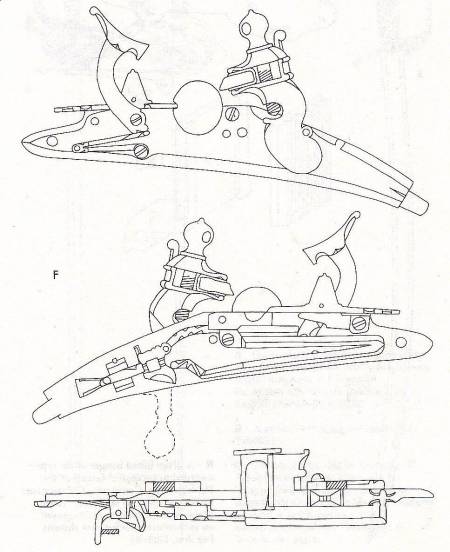
Lin Robinson
"The best thing in life is to crush your enemies, see them driven before you and hear the lamentation of their women." Conan the Barbarian, 1982
|
|
  |
 |
|
Perry L. Goss
|
 Posted: Sat 22 Jan, 2011 7:53 am Post subject: Snaphaunce locks Posted: Sat 22 Jan, 2011 7:53 am Post subject: Snaphaunce locks |
 |
|
Lin:
Have you ever used one of those? My experience confirms your posting.
I had a really good gunsmith use some manufactured locks from one of the historical reenactment suppliers, name unmentioned; and although the guns were beautiful, early styled, wood stocked, custom Ed Rayl cannon barreled .62 cal. - the locks were the pits! Constant adjustment, very picky. I finally sold them in disgust. I should have taken pictures but the gunsmith after going through them did not want the pics out there on the www because he did not want to deal with them again! 
Maybe one of these days I will just get some Chamber's flintlocks and do a later period brass stocked pistol. Still have not found anyone, yet - to take on the hammersmithing job for that!
Thank you
Scottish: Ballentine, Black, Cameron, Chisholm, Cunningham, Crawford, Grant, Jaffray, MacFarlane, MacGillivray, MacKay-Reay/Strathnaver, Munro, Robertson, Sinclair, Wallace
Irish/Welsh: Bodkin, Mendenhall, Hackworth
Swiss: Goss von Rothenfluh, Naff von Zurich und Solland von Appenzel
|
|
  |
 |
|
Lin Robinson
|
 Posted: Sat 22 Jan, 2011 8:14 am Post subject: Posted: Sat 22 Jan, 2011 8:14 am Post subject: |
 |
|
Perry...
While I have never had the experience of using a snaphaunce lock equipped gun, my favorite gunsmith has. He told me he had made a couple of snaphaunce locks but gave up after that due to maintenance and adjustment problems. He now makes locks which are equipped with Siler internals and outwardly appear to be snaphaunce locks coverted to flintlock by welding a pan cover onto the end of the frizzen or steel. I have two guns with his locks and while they look very good they do not have the problems inherent in the snaphaunce lock. Both guns are pictured in other posts on the forum.
There are folks out there who will assemble guns from The Rifle Shoppe's components. You can ask the folks at TRS, if you can reach them or google the information which is what I did.
By the way, Track of the Wolf www.trackof the wolf.com has one of the Indian made Murdochs on sale right now for $199.00 which is right about cost. It is missing the rammer and the touchole is not drilled but neither of those issues is serious. It was returned by a customer who thought the mainspring was too stiff and I can attest to that being a problem with those guns.
Lin Robinson
"The best thing in life is to crush your enemies, see them driven before you and hear the lamentation of their women." Conan the Barbarian, 1982
|
|
  |
 |
|
Matthew Amt
|
 Posted: Sat 22 Jan, 2011 9:40 am Post subject: Posted: Sat 22 Jan, 2011 9:40 am Post subject: |
 |
|
Weren't there some pieces from matchlocks recovered by archeologists from the gunsmith's shop at Williamsburg? They were discarded when older weapons were converted to flintlocks. I don't have a reference, I'm afraid, just dredging up an old memory. It still seems a little more firm than the rumor I heard that there were about 10 guys with matchlocks on the field at Lexington Green on April 19, 1775! Facing grenadiers and light infantry, eek...
Overall, yes, the colonies were better than average for modern weaponry. Possibly the older stuff survived better in more "civilized" areas simply because there wasn't as much warfare with the Indians, so less incentive to upgrade.
Sorry, mostly undocumented speculation!
Matthew
|
|
   |
 |
|
Lin Robinson
|
 Posted: Sat 22 Jan, 2011 9:53 am Post subject: Posted: Sat 22 Jan, 2011 9:53 am Post subject: |
 |
|
| Matthew Amt wrote: | Weren't there some pieces from matchlocks recovered by archeologists from the gunsmith's shop at Williamsburg? They were discarded when older weapons were converted to flintlocks. I don't have a reference, I'm afraid, just dredging up an old memory. It still seems a little more firm than the rumor I heard that there were about 10 guys with matchlocks on the field at Lexington Green on April 19, 1775! Facing grenadiers and light infantry, eek...
Overall, yes, the colonies were better than average for modern weaponry. Possibly the older stuff survived better in more "civilized" areas simply because there wasn't as much warfare with the Indians, so less incentive to upgrade.
Sorry, mostly undocumented speculation!
Matthew |
I seriously doubt there were any matchlocks at Lexington Green! Williamsburg is close enough to Jamestown to think that parts from matchlocks might have been found in the area. Whether they were the refuse from conversion of matchlocks to flintlock would be impossible to determine at this late date. A lot of snaphaunce lock guns came to the New World, along with wheelocks, as mentioned in Jack Englund's post above. However interesting it may be to think that some colonists retained matchlocks as their primary weapon for 100 years or more, that theory does not make a lot of sense. When newer and better technology became available it was adopted by most everyone immediately, especially since a well-made and efficient firearm was a matter of life or death for many.
Lin Robinson
"The best thing in life is to crush your enemies, see them driven before you and hear the lamentation of their women." Conan the Barbarian, 1982
|
|
  |
 |
Jack W. Englund

|
 Posted: Sat 22 Jan, 2011 6:24 pm Post subject: Posted: Sat 22 Jan, 2011 6:24 pm Post subject: |
 |
|
Matchlock long arm

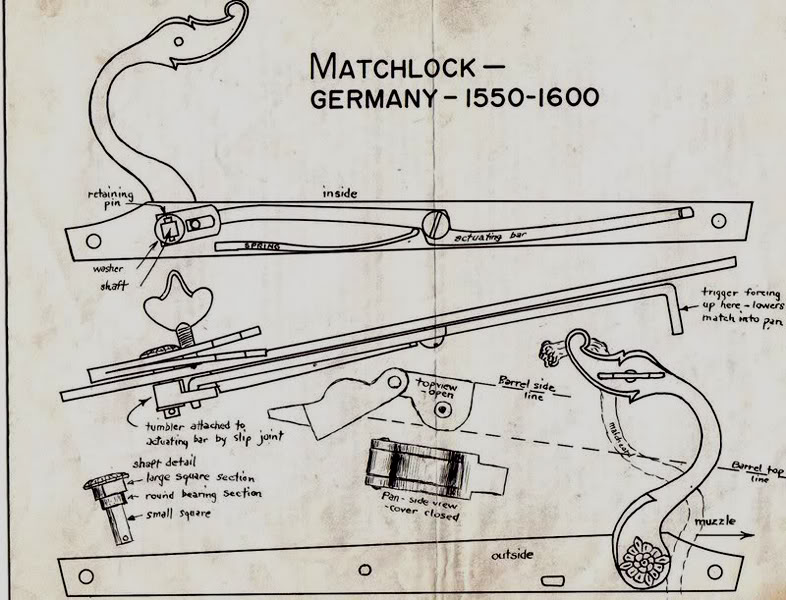
Wheel Lock long arm

Wheel Lock Pistol


Scots Snaphance
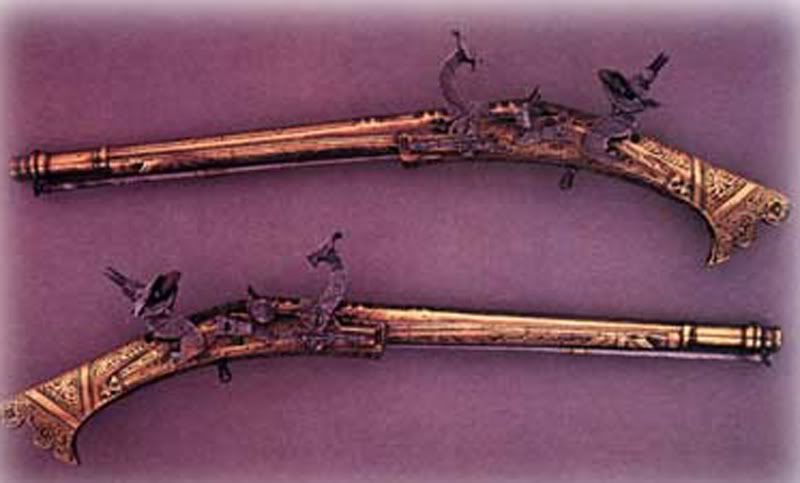

Snaphance Lock
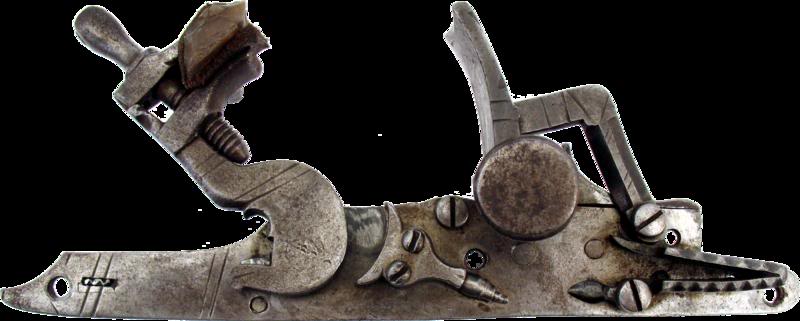
Scots snaphance lock found @ Jamestowne
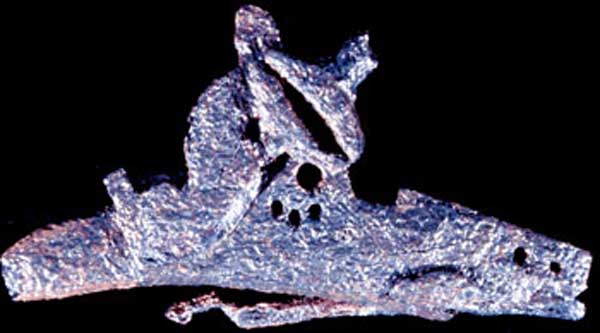
Scots snaphance pistol found @ Jamestowne
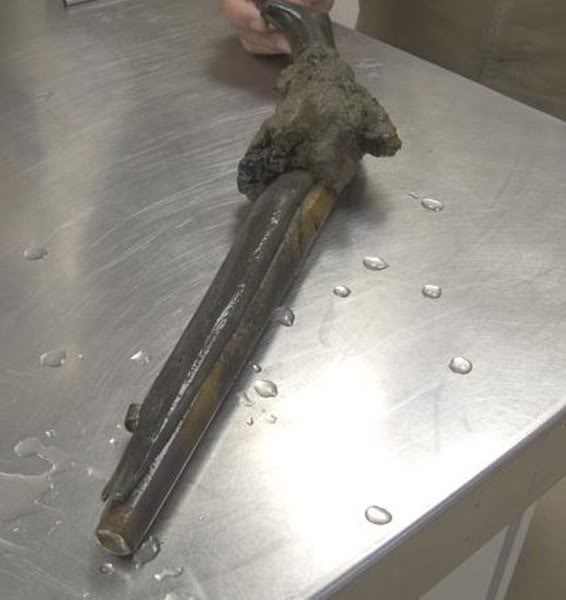
Jack
Last edited by Jack W. Englund on Sat 22 Jan, 2011 7:59 pm; edited 4 times in total
|
|
  |
 |
|
Lin Robinson
|
 Posted: Sat 22 Jan, 2011 6:58 pm Post subject: Posted: Sat 22 Jan, 2011 6:58 pm Post subject: |
 |
|
I have ordered, and hope to eventually receive, a replica of the Jamestown Scottish snaphaunce shown in the previous post. It has been nearly a year since I ordered. When I have it in hand I will post a photo on the forum.
Here is a b & w closeup of the lock on one of the pair of brass pistols in the previous post. If anyone is interested in more photos of Scottish pistols and other guns please send me a PM.
 Attachment: 40.73 KB Attachment: 40.73 KB
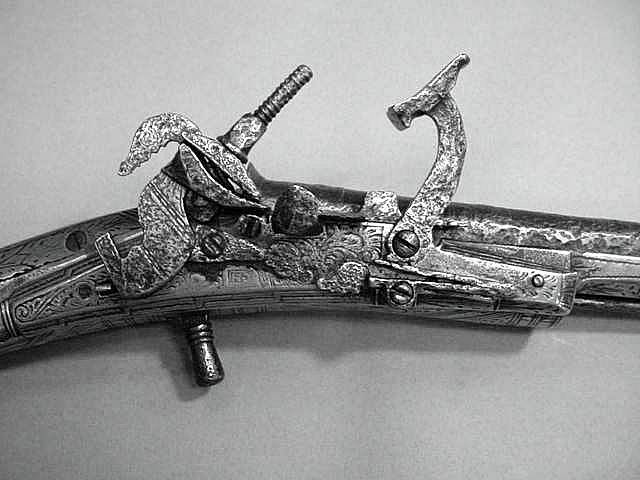
Lin Robinson
"The best thing in life is to crush your enemies, see them driven before you and hear the lamentation of their women." Conan the Barbarian, 1982
|
|
  |
 |
Jack W. Englund

|
 Posted: Sat 22 Jan, 2011 8:56 pm Post subject: Posted: Sat 22 Jan, 2011 8:56 pm Post subject: |
 |
|
Added info from
BANCROFT LIBRARY
THE LIBRARY OF THE UNIVERSITY OF CALIFORNL\ J. Porter Shaw Collection
FIREARMS IN AMERICAN HISTORY 7
With the advent of the thousand Puritans who
settled and named Boston in 1630, and who formed a
colony of considerable means, other firearms appear,
representing as private property all the types of fire-
arms then known (matchlock, wheellock, snaphance,
and flintlock, named in the order of their invention),
and as public property such as were then in common
military use in Europe. As prelude to the first
Indian war (the Pequot War, 1637) the Colonists
were for the first time able to equip a company with
weapons superior to those of the Indians. The fol-
lowing list, taken from the records of the Puritans,
shows some of the common property arms which
were purchased in 1628 or 1629 in anticipation of
their migration to the new country.
80 bastard muskets with snaphances and four foot barrels,
without rests.
6 fowling pieces
6i foot long.
musket bore.
4 fowling pieces
Sh foot long,
bastard musket bore.
10 full muskets, .
\ foot barrels.
matchlocks, and rests.
These ninety snaphance arms are the first public
property ones in quantity of which Colonial record
has been found. They may have been snaphance
as the term is now understood, and they may have
been true flintlock, for the names snaphance and
flintlock were then used indiscriminately.
8 FIREARMS IN AMERICAN HISTORY
With matchlock guns only it is doubtful if the
Colonists could have brought to a speedy termina-
tion the trouble with the Pequots. These Indians,
Jack
|
|
  |
 |
Keith Burgess

Location: New England Australia Joined: 20 Jan 2011
Posts: 26
|
 Posted: Sat 22 Jan, 2011 9:38 pm Post subject: Posted: Sat 22 Jan, 2011 9:38 pm Post subject: |
 |
|
| Lin Robinson wrote: | | Matthew Amt wrote: | Weren't there some pieces from matchlocks recovered by archeologists from the gunsmith's shop at Williamsburg? They were discarded when older weapons were converted to flintlocks. I don't have a reference, I'm afraid, just dredging up an old memory. It still seems a little more firm than the rumor I heard that there were about 10 guys with matchlocks on the field at Lexington Green on April 19, 1775! Facing grenadiers and light infantry, eek...
Overall, yes, the colonies were better than average for modern weaponry. Possibly the older stuff survived better in more "civilized" areas simply because there wasn't as much warfare with the Indians, so less incentive to upgrade.
Sorry, mostly undocumented speculation!
Matthew |
I seriously doubt there were any matchlocks at Lexington Green! Williamsburg is close enough to Jamestown to think that parts from matchlocks might have been found in the area. Whether they were the refuse from conversion of matchlocks to flintlock would be impossible to determine at this late date. A lot of snaphaunce lock guns came to the New World, along with wheelocks, as mentioned in Jack Englund's post above. However interesting it may be to think that some colonists retained matchlocks as their primary weapon for 100 years or more, that theory does not make a lot of sense. When newer and better technology became available it was adopted by most everyone immediately, especially since a well-made and efficient firearm was a matter of life or death for many. |
I can't agree with this, not because I have primary documentation, but because I don't believe everyone could afford to purchase new guns as they became available. There were a lot of poor people in the New World, and they purchased and used whatever they could afford.
• I gave orders to them to go home and fetch their arms whether guns, swords, pitchforks, axes or whatsoever might be of use against the enemy and for three days provision in their knapsacks”(early 18th century).
A Letter to Governor Morris from Conrad Weiser, Esqr,, at Reading.
An authentic history of Lancaster County : in the state of Pennsylvania
http://www.archive.org/stream/authentichistor...b_djvu.txt
“I went to the woods because I wished to live deliberately, to front only the essential facts of life and see if I could not learn what it had to teach, and not, when I came to die, discover that I had not lived.” Henry David Thoreau.
http://woodsrunnersdiary.blogspot.com/
|
|
   |
 |
Keith Burgess

Location: New England Australia Joined: 20 Jan 2011
Posts: 26
|
 Posted: Sat 22 Jan, 2011 10:48 pm Post subject: Re: Can't find book. Posted: Sat 22 Jan, 2011 10:48 pm Post subject: Re: Can't find book. |
 |
|
| Keith Burgess wrote: | | Lin Robinson wrote: | | If you are referring to The Matchlock Gun by Walter Edmonds then you are citing a work of fiction. However, the plot line for this book does not follow along with what you wrote so there may be another book out there by that name. I could not find anything on a book which approximates the story line you mentioned in your post. |
It is a very old book, and I doubt it is still in print. Though I did find a copy in the local library many years ago. |
Sorry, must disagree here. I have read this book, and the plot line is as I said. This story is based on a true story, which if you read the book you will find the true story in the preface.
The Matchlock Gun. Walter D. Edmonds.
Winner of the Newbery Medal, this stirring tale of a small boy, his mother and younger sister, and an antique matchlock gun, is based on a true story.[url] http://www.fishpond.com.au/product_info.php?i...[/url]This classic, first published in 1941, has an updated, kid-friendly format that includes the original black-and-white illustrations. ... [url] http://www.abebooks.com/9780698116801/Matchlo.../plp[/url]
“I went to the woods because I wished to live deliberately, to front only the essential facts of life and see if I could not learn what it had to teach, and not, when I came to die, discover that I had not lived.” Henry David Thoreau.
http://woodsrunnersdiary.blogspot.com/
|
|
   |
 |
|
Lin Robinson
|
 Posted: Sun 23 Jan, 2011 7:01 am Post subject: Posted: Sun 23 Jan, 2011 7:01 am Post subject: |
 |
|
Amazon.com has this book for sale. They also have a feature which allows a potential buyer to read a few pages and that happens to be available for this book. So, I have read the foreword which says that the characters, at least the father and mother, were real people and that is all it says as far as I could tell. It does say that the story was handed down. This does not mean, of course, that what is in the book is faithful to the actual events. Indeed, as I am sure you know, plenty of fictional works are "based on fact". However they do not always follow the facts on which they are based to the letter.
When you first posted your comments saying that you had a reference to a matchlock being used in the French and Indian War, I thought you meant an historical reference from either the public record or an eyewitness account but that is not the case. I will concede that it is possible that a matchlock or two may have been used in that time period but I still find it extemely unlikely.
People who could not afford a firearm and naturally there were some on the frontier at that time, simply didn't have them. What I thought we were discussing was the firearms which were used on the frontier during the mid-18th c., not the affordability of these firearms.
There is an interesting book available called Of Sorts for Provincials by Jim Mullins, which illustrates and discusses the firearms and a few edged weapons used by colonists during the French and Indian War. While the high quality color photos of original firearms from the era are the main attraction of the book, there is also quite a bit of text. Of particular interest in this discussion is the section on "composite muskets", i.e. guns assembled from parts. These guns were probably available at a much lower price than the standard firearm and may have filled the gap for those unable to afford anything better. Also, keep in mind that the colonial government issued arms to militias, when they were available, although these were usually older, lower grade firearms as the best were reserved for regular troops.
The photos of the Scottish pistols were interesting and thank you for posting them.
Lin Robinson
"The best thing in life is to crush your enemies, see them driven before you and hear the lamentation of their women." Conan the Barbarian, 1982
Last edited by Lin Robinson on Wed 02 Feb, 2011 3:21 pm; edited 1 time in total
|
|
  |
 |
|
|
You cannot post new topics in this forum
You cannot reply to topics in this forum
You cannot edit your posts in this forum
You cannot delete your posts in this forum
You cannot vote in polls in this forum
You cannot attach files in this forum
You can download files in this forum
|
All contents © Copyright 2003-2025 myArmoury.com — All rights reserved
Discussion forums powered by phpBB © The phpBB Group
Switch to the Basic Low-bandwidth Version of the forum
|

